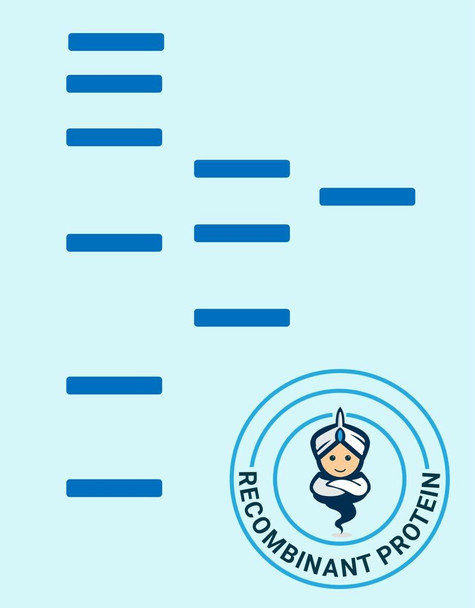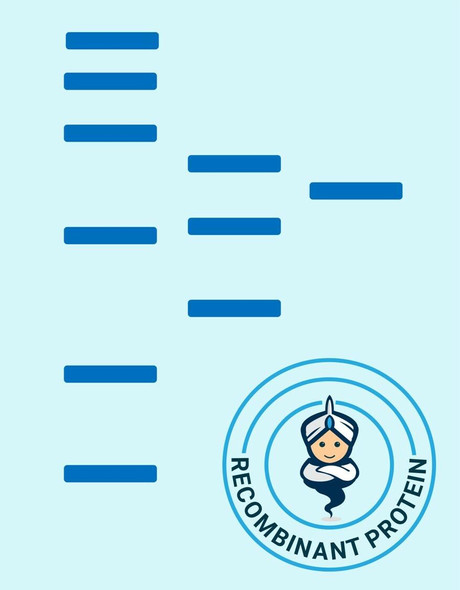Human BAG1 Recombinant Protein (RPPB2847)
- SKU:
- RPPB2847
- Product type:
- Recombinant Protein
- Size:
- 20ug
- Species:
- Human
- Target:
- BAG1
- Synonyms:
- BAG-1
- Bcl-2-associated athanogene 1
- RAP46
- Bcl-2-binding protein
- Source:
- Escherichia Coli
- Uniprot:
- Q99933
Description
| Product Name: | Human BAG1 Recombinant Protein |
| Product Code: | RPPB2847 |
| Size: | 20µg |
| Species: | Human |
| Target: | BAG1 |
| Synonyms: | BAG-1, Bcl-2-associated athanogene 1, RAP46, Bcl-2-binding protein, HAP. |
| Source: | Escherichia Coli |
| Physical Appearance: | Sterile filtered colorless solution. |
| Formulation: | BAG1 Human solution containing 20mM Tris-HCl pH-7.5, 0.1M NaCl and 10% glycerol. |
| Stability: | Store at 4°C if entire vial will be used within 2-4 weeks. Store, frozen at -20°C for longer periods of time. For long term storage it is recommended to add a carrier protein (0.1% HSA or BSA).Avoid multiple freeze-thaw cycles. |
| Purity: | Greater than 90% as determined by SDS-PAGE. |
| Amino Acid Sequence: | MNRSQEVTRD EESTRSEEVT REEMAAAGLT VTVTHSNEKH DLHVTSQQGS SEPVVQDLAQ VVEEVIGVPQ SFQKLIFKGK SLKEMETPLS ALGIQDGCRV MLIGKKNSPQ EEVELKKLKH LEKSVEKIAD QLEELNKELT GIQQGFLPKD LQAEALCKLD RRVKATIEQF MKILEEIDTL ILPENFKDSR LKRKGLVKKV QAFLAECDTV EQNICQETER LQSTNFALAE |
BAG1 binds to BCL2 and is also called BCL2-associated athanogene. BAG1 increases the anti-apoptotic effects of BCL2 and is characterizes as a link between growth factor receptors and anti-apoptotic mechanisms. BAG1 inhibits the chaperone activity of HSP70/HSC70 by promoting substrate release. BAG1 inhibits the pro-apoptotic function of PPP1R15A, and has anti-apoptotic activity. BAG1 enhances the anti-cell death function of BCL2 induced by various stimuli.
BAG1 Human Recombinant produced in E.Coli is a single, non-glycosylated,polypeptide chain containing 230 amino acids (1-230 a.a.) and having a molecular mass of 25.9 kDa. BAG1 protein is purified by standard chromatography.
| UniProt Protein Function: | BAG1: Inhibits the chaperone activity of HSP70/HSC70 by promoting substrate release. Inhibits the pro-apoptotic function of PPP1R15A, and has anti-apoptotic activity. Markedly increases the anti-cell death function of BCL2 induced by various stimuli. Homodimer. Forms a heteromeric complex with HSP70/HSC70. Binds to the ATPase domain of HSP/HSC70 chaperones. Isoform 1, isoform 3 and isoform 4 but not isoform 2 interact with HSPA8/HSC70. Interacts with NR3C1. Interacts with the N-terminal region of STK19. Interacts with PPP1R15A. Interacts with BCL2 in an ATP-dependent manner. Isoform 2 does not interact with BCL2. Up-regulated during differentiation of bladder epithelial cells and down-regulated during differentiation of prostate epithelium. Isoform 4 is the most abundantly expressed isoform. It is ubiquitously expressed throughout most tissues, except the liver, colon, breast and uterine myometrium. Isoform 1 is expressed in the ovary and testis. Isoform 4 is expressed in several types of tumor cell lines, and at consistently high levels in leukemia and lymphoma cell lines. Isoform 1 is expressed in the prostate, breast and leukemia cell lines. Isoform 3 is the least abundant isoform in tumor cell lines. 4 isoforms of the human protein are produced by alternative splicing. |
| UniProt Protein Details: | Protein type:Nuclear receptor co-regulator; Motility/polarity/chemotaxis Chromosomal Location of Human Ortholog: 9p12 Cellular Component: cytoplasm; nucleus Molecular Function:protein binding; chaperone binding; receptor signaling protein activity Biological Process: cell surface receptor linked signal transduction; apoptosis; negative regulation of apoptosis |
| NCBI Summary: | The oncogene BCL2 is a membrane protein that blocks a step in a pathway leading to apoptosis or programmed cell death. The protein encoded by this gene binds to BCL2 and is referred to as BCL2-associated athanogene. It enhances the anti-apoptotic effects of BCL2 and represents a link between growth factor receptors and anti-apoptotic mechanisms. Multiple protein isoforms are encoded by this mRNA through the use of a non-AUG (CUG) initiation codon, and three alternative downstream AUG initiation codons. A related pseudogene has been defined on chromosome X. [provided by RefSeq, Feb 2010] |
| UniProt Code: | Q99933 |
| NCBI GenInfo Identifier: | 296439462 |
| NCBI Gene ID: | 573 |
| NCBI Accession: | Q99933.4 |
| UniProt Secondary Accession: | Q99933,O75315, Q14414, Q53H32, Q5VZE8, Q5VZE9, Q5VZF0 Q96TG2, Q9Y2V4, |
| UniProt Related Accession: | Q99933 |
| Molecular Weight: | 345 |
| NCBI Full Name: | BAG family molecular chaperone regulator 1 |
| NCBI Synonym Full Names: | BCL2-associated athanogene |
| NCBI Official Symbol: | BAG1 |
| NCBI Official Synonym Symbols: | HAP; BAG-1; RAP46 |
| NCBI Protein Information: | BAG family molecular chaperone regulator 1; Bcl-2-binding protein; receptor-associated protein, 46-KD; Bcl-2 associating athanogene-1 protein; glucocortoid receptor-associated protein RAP46 |
| UniProt Protein Name: | BAG family molecular chaperone regulator 1 |
| UniProt Synonym Protein Names: | Bcl-2-associated athanogene 1 |
| Protein Family: | BAG family molecular chaperone regulator |
| UniProt Gene Name: | BAG1 |
| UniProt Entry Name: | BAG1_HUMAN |









